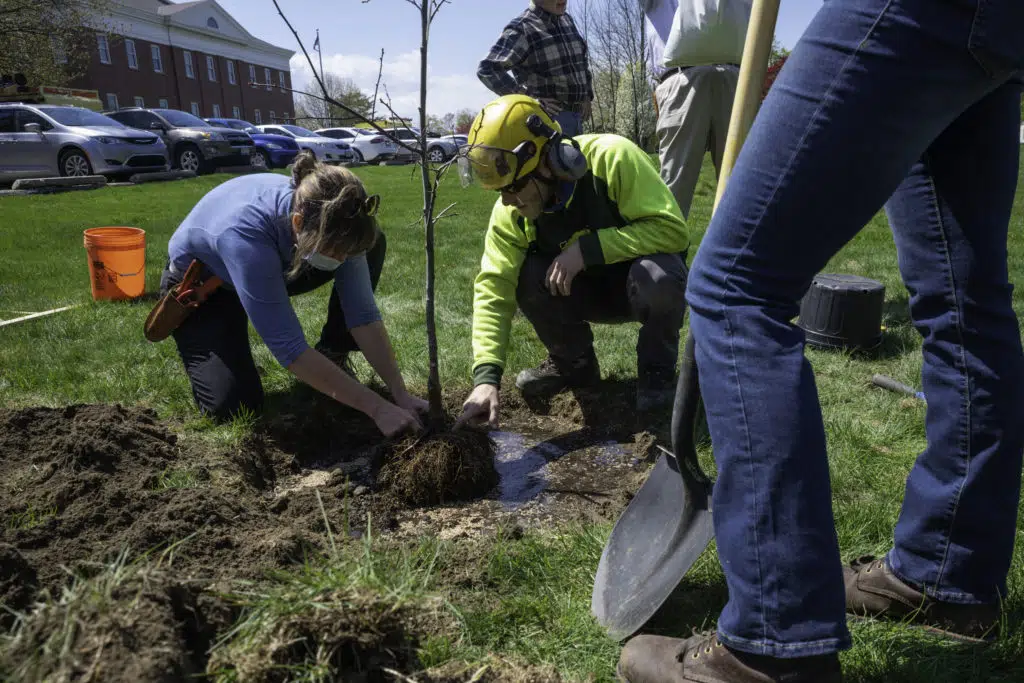
Certain types of trees are generally recommended to be planted in spring and not in fall, especially after early October. If a tree was dug in late summer, or planted from a container that is not root bound, then fall planting is often not much of a risk. Balled and burlapped (B&B) trees typically recommended for early spring planting here include Magnolia, tulip-tree (Liriodendron) sweet gum (Liquidambar), most oaks (Quercus), tupelo (Nyssa), bald-cypress (Taxodium), Ginkgo, giant arborvitae (Thuja plicata), and Chinese hemlock (Tsuga chinensis). Bill Hendricks, President of Klyn Nurseries, Perry, Ohio discussed this with me recently. Bill says you can plant B&B oaks in fall, but they must be dug from the nursery in spring or in late August or early September.
Spring planting should be accomplished in late March through April before new shoots have emerged from bud. When shoots are actively growing, less resources are available for root growth. If a significant percentage of roots are lost in transplanting in May or early June, actively growing new shoots wilt and the tree may die. When the shoots are not actively elongating is the best time to plant since more resources are devoted to root growth which for many trees starts to pick up again in July. August through early October is a prime time for root growth if soil is not too dry, so this is a fine time to plant many trees including conifers such as spruce (Picea) and pine (Pinus)given that you keep up with watering until adequate rains fall.
Evergreens in general are best planted in late summer. David G. Leach would plant his Rhododendron in August and September giving them time to establish before winter, not to mention the next summer. When soil temperatures drop in fall, root growth slows and then ceases by the end of December most years in northeastern Ohio. Trees such as white spruce (Picea glauca) can be successfully planted in late December. My father used to have a balled and burlapped white spruce indoors only for two days or so before my brothers and I helped him plant them the day after Christmas (they all lived). Straw was spread over the pre-dug planting site to keep the soil from freezing.
Trees that are generally challenging to dig after early September include Katsura tree (Cercidiphyllum), redbud (Cercis), yellowwood (Cladrastis), dogwood (Cornus), beech (Fagus), larch (Larix), golden larch (Pseudolarix), sycamore or London planetree (Platanus), Japanese pagoda tree (Styphnolobium a.k.a. Sophora), and Zelkova which require soil temperatures of about 56 degrees F. or higher to grow new roots. Other trees that are at risk when dug in fall include birch (Betula), flowering cherries (Prunus), poplar (Populus), and willow (Salix).

The roots of Magnolia, Liriodendron, and Ginkgo are relatively coarse and do not regenerate quickly enough when planted in fall to establish or ward off root rot that can occur on cut roots during our wet winters. Trees that are marginally hardy here such as bald-cypress, sweetgum, giant arborvitae, or Chinese hemlock can suffer significant dieback or may even die if stressed going into winter by transplanting. Tupelo like many oaks is tap rooted and is not recommended for fall digging. However, we have had success at Holden Arboretum planting tupelo and other hardy trees mentioned above from containers in October and November given that they are not overly root-bound.
For containerized trees it is important to cut circling roots near the top of the pot back to where they are pointed out away from the trunk, so they do not grow around the expanding trunk and choke it in the future. Stem girdling roots cause significant mortality in landscape trees. The necessity of cutting these roots makes timing of planting more relevant so new roots can establish themselves readily. Therefore, late summer to early fall is generally the best time to plant trees in northeastern Ohio. Even if the tree loses leaves in hot dry weather, most of the food has been made in spring, so losing leaves in late summer does not hurt the tree much. Early spring planting is also desirable since the tree will regulate new shoot growth according to how many roots it has lost and while top growth may be slow at first, resources are being allocated for new roots to get established so the tree can thrive.
Trees with a reputation of low transplant success such as American hornbeam (Carpinus caroliniana), sourwood (Oxydendrum arboreum), Carolina hemlock (Tsuga caroliniana), and Franklinia are best moved in late summer or early spring. At Holden, trees are generally not fertilized once they are planted as fertilizers can inhibit mycorrhizal fungi, which transfer nutrients to trees at no cost.
Bare-root trees are not commercially available, but you may want to DIY. I had success on a rainy April day bare-rooting an umbrella magnolia (Magnolia tripetala) from Ellen McFarland, putting it in the back of Corliss Knapp Engle’s Saab with the roots hanging out the back on the way to her Brookline, Massachusetts garden. In late October we successfully bare-rooted a sixteen-foot tall ‘Arnold Promise’ witchhazel (Hamamelis x intermedia) in the Engle garden that some experts said would be a failure.
Healthy trees are resilient. Plant appropriate trees at the right time with important people in your life. You will never regret it.

Ethan Johnson
Plant Records Curator
Ethan learned to keep plant records while working for the Arnold Arboretum (1985-89) and Holden Arboretum (1981-82, ‘89-present) while volunteering for the International Dendrological Research Institute, Ohio Nursery and Landscape Association Plant Selection Committee, and the American Conifer Society. He was the point person when the American Association of Museums accredited Holden Arboretum as the sixth public garden in the U.S. as a museum in 2001, has curated the Storer Herbarium, mapped, labeled, and inventoried Holden Arboretum’s plant collection. Starting in 2015 Ethan has been responsible for keeping plant records at Cleveland Botanical Garden.












